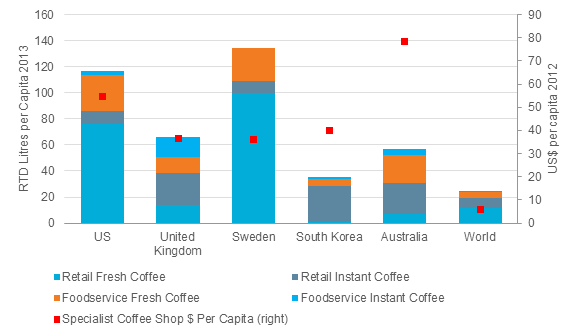Spirits Identifying the Key Trends for 2014 Analyst Insight from Euromonitor International
Post on: 16 Март, 2015 No Comment

Spirits: Identifying the Key Trends for 2014
 Whiskies: Beating the Dram
From verification schemes to ambitious and hefty investments in increasing production capacity and from a partial breakaway from the age statement taboo to flavour sophistication experiments, overproof extensions, ‘cocktail forward positioning’ and the rise of Japanese varietals, whiskies will continue holding the sceptre among the key spirits categories for the foreseeable future.
Reiterating Euromonitor International’s earlier commentary and cautionary projections, the flavoured fad appears to be stalling in the key US market. With pre-prohibition classics monopolising the upmarket cocktail arena across the West and additional rises planned for minimum prices in the already moribund Russian market. headwinds for this most ubiquitous of spirits are expected to be severe in the short term. Vodka’s unrivalled mixability will remain its most important line of defence, but additional avenues for clawing back growth potential from the inevitable peak of the flavoured segment will prove critical; a potential revisiting of proprietary-flavoured recipes, harking back to the category’s rich Eastern European heritage, could assist in overcoming the alcopop-like hangover and saccharine fatigue.
Providing a platform for playful experimentation through flavoured extensions for historically conservative, conformist and traditionalist categories like Scotch whiskies and tequila, liqueurs will cement their fledging momentum. Premium offerings will also increasingly make an impact, both as cocktail ingredients and exotic local specialties, capitalising on the millennial generation’s adventurous palates and their pursuit of unique narratives.
Major cognac houses’ monolithic focus on luxury sales to China is already casting a long shadow on their deliriously optimistic projections suggesting infinite growth. While bespoke, personalised and limited editions will continue to target the country’s nouveau riche, a sea change is already underway following the Chinese politburo’s crackdown on lavish consumption. A shift in positioning away from bling associations and into craftsmanship-driven propositions will signal the coming of age for the premium end of the category in China. On the other hand, entry-level VS offerings will be utilised as a safety net, capturing aspirational middle-class drinkers that are looking for more affordable and casual hues of Westernisation. Across Western markets, the focus will be on embracing mixology, deconstructing the category’s traditionalist connotations and expanding sales beyond the limitations of special occasions.

Above and beyond the sobering top line figures reeling under the weight of the declining Indian dark rum market, the category will retain its otherwise healthy trajectory, while driven by golden and aged varietals, alongside the solid spiced rum niche. The likes of Kraken and Sailor Jerry – both interestingly boasting their own unique narratives, designs and cult following that are proving as appealing to millenials as their signature flavours – will spearhead rum’s Western mainstream aspirations. On the other hand, premiumisation will continue unabated as aged expressions will increasingly jostle with whiskies for a share of mind and wallet in metropolitan centres across developed and emerging nations alike.
The gin renaissance is now in full swing. It involves hipster ambassadors and adventurous mixologists, a dollop of English eccentricity and American irreverence, a cornucopia of botanicals and a new generation of mixers. A unique, surreal and edgy brand narrative will continue to be the real protagonist, while micro-distilleries popping up across the UK (and beyond) will inevitably become the category’s flag bearers and evangelists. While volume growth will remain relatively subdued, the value growth story will finally establish the category as a mainstay of the premium proposition. Whispers of a lingering juniper crisis are probably exaggerated but should be watched closely for the potential to derail the current boom, while diversification will be essential in escaping the potential for macroeconomic headwinds in the category’s limited number of core markets.
From consolidation initiatives bringing local specialties under the limelight to the nostalgia-inspired revisiting of categories once exiled to the furthest shelves of the proverbial drinks cabinet, other spirits continues to hold huge potential. Euromonitor International’s previous assertions highlighting baiju, cachaca, pisco, raki, and absinthe as niches to watch out for have all been proven correct. Now it is time for moonshine. Capitalising on the romanticised view of the prohibition era still sweeping the US and the a priori embrace of the localisation and micro-distilling trends by such once vilified products, alongside a uniquely controversial narrative, premium versions of moonshine could finally enter the mainstream. Centerview Capital’s recent investment in Ole Smokey Tennessee Moonshine and Short Mountain Distillery’s recreation of a 100-year-old bootlegger’s recipe are merely the first signs of the trend to come. 














